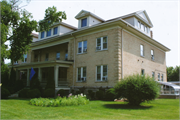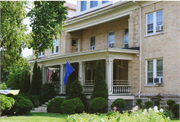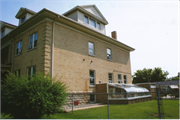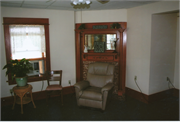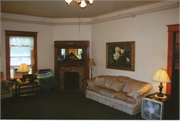Property Record
1628 N MAIN ST
Architecture and History Inventory
| Historic Name: | Ladies Benevolent Society Home |
|---|---|
| Other Name: | Winnebago County Home for the Retarded; Centennial Inn |
| Contributing: | Yes |
| Reference Number: | 70795 |
| Location (Address): | 1628 N MAIN ST |
|---|---|
| County: | Winnebago |
| City: | Oshkosh |
| Township/Village: | |
| Unincorporated Community: | |
| Town: | |
| Range: | |
| Direction: | |
| Section: | |
| Quarter Section: | |
| Quarter/Quarter Section: |
| Year Built: | 1902 |
|---|---|
| Additions: | 1924 |
| Survey Date: | 19782013 |
| Historic Use: | live-in care facility/sanitarium |
| Architectural Style: | Colonial Revival/Georgian Revival |
| Structural System: | |
| Wall Material: | Brick |
| Architect: | William Klapproth (architect); Gill & Frank (contractor); Mayer & Domke (mason) |
| Other Buildings On Site: | N |
| Demolished?: | No |
| Demolished Date: |
| National/State Register Listing Name: | Not listed |
|---|---|
| National Register Listing Date: | |
| State Register Listing Date: |
| Additional Information: | A 'site file' exists for this property. It contains additional information such as correspondence, newspaper clippings, or historical information. It is a public record and may be viewed in person at the Wisconsin Historical Society, Division of Historic Preservation-Public History. This Georgian Revival design consists of a recessed entrance area flanked by side wings. Brick quoins appear on the wings: a large central domer emphasizes the entrance with smaller dormers flanking. An original semicircular portico was replaced by a one-story porch after it was destroyed by fire on 18 March 1914. "The Home," built in 1902 as a residence for elderly women, was one of many projects undertaken by the Ladies Benevolent Society in Oshkosh. The building is historically significant due to its connection with the Society which was organized to assist the Civil War homefront effort in 1861. It was the first such group organized in the state and is still in operation. Most of the prominent ladies in the city have belonged to the Society. One of its founders was Mrs. Philetus Sawyer and Jesse Jack Hooper was later an active member and, eventually, President of the Society. The building served its original purpose until 1974. Resurveyed: "N Main Street Architecture/History Survey," WisDOT #4994-01-14, Prepared by Heritage Research (2013) DOE COMPLETED IN 2013 BY HERITAGE RESEARCH: The origins of Oshkosh’s Ladies Benevolent Society date to 1862 when a group of women met to make bandages for Civil War soldiers. Then known as the Ladies Aid Society, the group’s work expanded into providing food and clothing to needy families whose men had departed for war. The society after the war continued to provide material assistance to needy families and it changed its name in 1865 to the Ladies Benevolent Society. The need for assistance greatly increased in Oshkosh after an 1866 fire devastated much of the city. Donations to the society increased and it acquired a parcel of land on Irving Street in 1872 and incorporated on 8 January 1873. Throughout the 1870s, the society collected material and monetary donations and sent a visiting committee to the city’s six wards to validate calls for assistance. By this time, the society had concentrated its efforts on elderly, indigent women without other means of assistance; however, it also provided small loans to veterans and assisted them in securing their pensions, as well as provided assistance to anyone else demonstrating need. In 1878, the society considered opening a home for such women and rented a house on Central Avenue; however, no one chose to utilize it and the project was abandoned later that year. In 1879, the society organized a donation day where the general public was solicited for donations; its success resulted in it being an annual event. At the close of 1880, the society had 62 members, mostly drawn from Oshkosh’s middle class. In 1888, an Oshkosh city official met with the society about coordinating relief for the poor. With a firm financial footing and support from city officials, the society once again discussed founding a home for the indigent. A fund was set up with the first major donations consisting of ten $100 donations from area businessmen. The group purchased the “Eighme Homestead on North Main Street” for $4,000 in donations and proceeds from the sale of the Irving Street parcel. The “Home for the Friendless” opened in September 1890. The home served twenty-seven people over the next four years, by which time it has been renamed “The Home.” During the 1890s, the society, which by now numbered 130 members, had become engrained in Oshkosh’s social fabric. Organizations such as the Masons donated use of their lodge for society meetings and fundraising events such as community suppers and dances. Church groups contributed part of their collections from their own fundraising efforts and proceeds from many plays, sporting events and other types of entertainment found their way into the society’s coffers. Area businesses were known to offer a day of proceeds to the society and Oshkosh’s National Guard unit held a dance in their armory in benefit of the organization. Requests for assistance at the home exceeded capacity and planning for a new and larger home for the society began in 1899. Fundraising began when Wisconsin Senator Philetus Sawyer pledged $5,000 to a home endowment fund. A building committee was appointed and two lots on N. Main Street were acquired. The society hired architect William Klapproth to design the $15,000 building. The Oshkosh firm of Gill & Frank was the builder with the masonry work completed by Mayer & Domke. The first floor at the main entrance featured a reception hall with oak staircase. To the south were matrons’ rooms, parlor, transient room (for visitors and new residents), recreation room, kitchen and dining room. Meanwhile, the north end of the building contained a parlor with fireplace and six resident rooms (9’ by 12’) and bathroom. Fourteen resident rooms and a hospital room (present-day parlor) were located on the second floor. The basement consisted of two hot water boilers, vegetable cellar, laundry, three cisterns and storage. A fire destroyed the two-story portico in 1914. It was replaced with the current porch ten years later. Generally, during the era prior to World War II, the home housed around fifteen residents along with an ever-changing combination of a matron, nurses and maids. A janitor lived off site. A waiting list for entry was typical. The society maintained the home through a variety of community fundraisers, individual donations and awards from the Oshkosh Welfare Fund – a community chest organization. The Oshkosh Visiting Nurses Association assisted with care of the residents into the early 1930s. The Ladies Benevolent Society and the home remained fixtures within the Oshkosh community after World War II and into the 1960s. By the early 1970s, government regulation had made it difficult for the society to provide care at the home. In 1974, the society agreed to close the facility and transfer its residents to Evergreen Manor, a local nursing home. The building then was sold to the Winnebago County Association of Retarded Citizens, which used the facility for its residents. In 1992, the building became the Centennial Inn, a senior living facility; it continues in that role today. Meanwhile, the Ladies Benevolent Society remains an active organization in Oshkosh assisting the elderly. |
|---|---|
| Bibliographic References: | (A) Karsteadt, Oshkosh, 100 Years a City, p. 31. (B) Interview with Mrs. Jane Gunther President of the Ladies Benevolent Society, by C. Causier 2/12/81. (C) Oshkosh Daily Northwestern 6/14/74. (d) "Ladies Benevolent Society: Advocates for Older Adults" (N.p.: n.d), Located at Oshkosh Public Library. (e) "The Home of Benevolent Society to be Occupied May 1st," Oshkosh Daily Northwestern, 15 March 1902, pg 1 (f) "Fire Sweeps 'Home', Inmates Taken Out," Oshkosh Daily Northwestern, 18 March 1914, pg 12. |
| Wisconsin Architecture and History Inventory, State Historic Preservation Office, Wisconsin Historical Society, Madison, Wisconsin |

